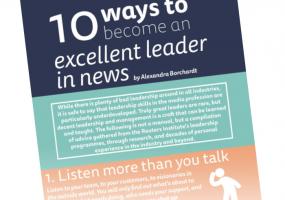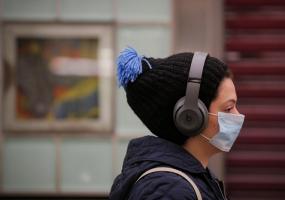A world without journalists? Fear not
29 Jan 2013
Federico Guerrini writes: Imagine a world without journalists. For all the fears about the future of the profession, barely a decade ago just the thought of it would have caused a burst of laughter. How were people supposed to get their news, if not through the media? Facebook was established only in 2004; Twitter a couple of years later: the power of social media had yet to show up. "Now, the absence of professional journalists," – explained Paul Lewis, award winning reporter of the Guardian, during a captivating seminar– "would of course cause major problems and disruptions, but the information could still find a way to flow and reach the audience". Does it mean that we have to prepare for a scenario of "News without journalists?" in accordance with the title of Paul's speech? Fear not. From what was said in the lecture, there's still room for professionals, as long as they're able to interpret their role in new ways that take advantage of the new tools available. To all those still convinced that Twitter is just a fashion and a place for gossip, the Guardian's use of the micro-blogging site to cover the England riots in 2011 – as depicted in the presentation given at RISJ - will surely prove to be a mind opening experience. But in Lewis’ talk there was much more than that. Debunking the official version The use of Twitter by journalists, of course, didn't start with the riots. The Guardian itself had used it before with positive results to aid its investigations, on at least a couple of occasions. First, in the case of the mysterious death of English newspaper vendor Ian Tomlinson during the 2009 G-20 summit protests. After the incident, most of the press stuck to the police account that Tomlinson had died of a heart attack while walking home from work. But with the help of social media, pictures released on Flickr and witnesses found thanks to Twitter, another truth began to emerge. One of the witnesses also handed Lewis a video, that was later published by the Guardian on You Tube. It showed a police officer beating the news vendor with a baton after no apparent provocation. Something similar happened with the death of Jimmy Mubenga, an Angolan detainee who died while being deported from Heathrow on 12 October 2010. In this case as well, the official version was not crystal clear. So, the Guardian's team tracked down some passengers on Mubenga's flight, asking for their help via Twitter, using keywords and hashtags in order to make it easy to discover the article published on the newspaper's website to anyone who might have been involved. And, as with Tomlinson’s death, an alternative narrative emerged, especially after someone reported having seen the police forcibly restrain Mubenga to his seat and the man begging for help. Both Tomlinson's and Mubenga's cases were instances of citizen aided investigations, in which the power of social media was unquestionable, but the reporter still played a fundamental role. As for the former, there were meetings in person with people that provided the footage and the pictures posted on the Internet and the content was verified and contextualized by the journalists. In the latter, that was not possible, and alternate means of verification were found. “I asked one of the passengers to send me via email his boarding pass," – Paul recalled – "and to do it in 15 minutes, in order not to make it possible for him to produce a forgery". Another checking device was to ask details, provided by another, confirmed source, that only someone present at the scene could know. All these experiences became part of the tool kit of The Guardian's journalists. And when the riots broke, Lewis and his colleagues were prepared. No longer distant observers Like so many things, even social media are a game of give and take. A reporter who knows how to use them can gain a lot, as the previous stories show. But he also has to give up something in exchange: above all, his pretence of complete neutrality. "Journalists like to think of themselves as distant observers" – said Lewis – “detached from the facts, but, in my view, it's not possible to operate like this with social media, at least to operate successfully. To some degree, you're forced to let people know how you think and feel about a story". This recalibrates your relationship with the reader which sees you like a peer with whom to cooperate, instead of an authoritative, but distant, source of information. It's not a coincidence that of the three most re-tweeted accounts during the riots, two were individuals, the very same Paul Lewis and Piers Morgan, and the third was a profile created to coordinate the repairing of the damages (@riotcleanup). Established news organizations lagged behind. People gave advice and guidance to figures they trusted and respected. "I received a lot of messages" – says Lewis – "often at three or four in the morning, saying: go over there, there's something that's going to happen". That helps, especially in the case of an event like the riots, the biggest unrest in UK since the 80's, deployed on a scale that would require an army of journalists to cover with traditional strategies. The wisdom of the self-correcting crowd But what about rumours? Social media are also a great way of spreading disinformation, right? According to Paul Lewis, wrong. Or only partially true, at least. One of the side effects of the research project "Reading the riots" conducted by the Guardian together with the London School of Economics in the year that followed the protests, was to throw light on the way in which rumours spread and were countered when false. From the analysis of 2.6 million tweets a common pattern emerged. “In many cases – explains Lewis – like when news spread that some animals escaped from London zoo, it was the same kind of people that sent false information that helped to clarify it”. So a picture of a large cat that seemed to prove the claim, was quickly spotted by another user as pertaining to a tiger that fled from a zoo in Rome, some years before. This job of verification was done organically and often independently from journalists. "It was like people felt compelled to establish the truth about what was going on". That doesn't mean that false rumours don't appear and can't be a source of potential trouble; those in media, in Lewis' view, have the moral obligation to be very careful on how to proceed and not re-tweet or in other way endorse claims that have not been thoroughly verified. And the best results, the Guardian journalist believes, are obtained by professionals that are on the ground as well as in front of the screens. On this, Lewis's position differs a little from that of other well-known professionals, like NPR's Andy Carvin, who gained international recognition for his covering of the Arab Spring, done mainly from the U.S., via social media. Curation? Yes, please. But in-house You just can't set up multiple Twitter feeds and wait for the news to rush through, of course. Together with people on the ground, the Guardian had a team of three to four editors that worked from the office, contextualizing and integrating the stories that were pushed by the journalists and by the users. In others words, they curated and edited the news. The main platform for doing this seems to have been the Guardian live blogs. In his talk, Lewis seemed somewhat sceptic on the usefulness, for a newspaper like his, of third party tools such as Storify or Storiful. The first is a Web based platform that allows both professional journalists and amateurs to collect and organize multimedia material gathered from different sources: social media like Facebook and Twitter, Google searches, news outlets. The latter is an Irish journalistic startup whose mission is to help media organizations verify user generated content. "I think Storify is a good and interesting service, but I can't see exactly how it's different from a live blog", he said. He also pointed out the advantage, for "citizen journalists" of being able to rely on a well-established brand to help their content become viral. In the case of the footage that shed light on Ian Tomlinson's death, for instance, the person who shot it could have decided to place it directly on YouTube. But the risk would have been that it could have remained unnoticed for weeks, in the deluge of multimedia content that flooded the Net during that period. It's not over when it's over: a kaleidoscopic memory of the facts The "Reading the Riots" project also showed something else: the way messages posted on Twitter might be used as a "kaleidoscopic memory" of an event. And to confirm or deny a posteriori conclusions. In the bewildering and mixed up days of the riots, social media themselves were accused of helping coordinate violence and looting. An analysis of the 2.6 million tweets provided by Twitter to the Guardian showed that this was not true. Actually, while some of the protesters coordinated via smartphones (mainly through Blackberry's Messenger service), social media were used above all consciously for the good, to help restore normality and clean up the streets. Not to mention the fact that the police used pictures and videos uploaded on Flickr and YouTube to track and arrest many rioters. The future of newspapers Last, but not least, Lewis spoke about the financial future of newspapers. The Guardian has been following the "digital first" approach for several years and, like most of its rivals, struggles with the issue of generating revenue in an evolving business scenario. "It may be difficult – said the journalist – but I think I'm lucky to be at the Guardian, because we can experiment and try to be, in five to six years, at the forehead of the digital revolution." The paper is currently trying to earn money through different strategies: one is to rapidly increase its international audience: operations in the US have been expanded and an office has just been opened in Australia. Another way to get cash is through philanthropy. The Reading the Riots project is one example of that: the money to fund the research was provided by the Joseph Rowntree Foundation and the Open Society Foundations. Not every kind of journalism could be funded this way, of course: it's difficult to think of a gossip tabloid being funded by a charity or NGO. But NGO support could prove a viable solution for newspapers addressing broad social issues the way the Guardian does.




